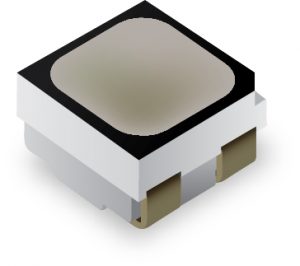
 To discuss what an LED display wall is — and how it can enhance the worship experience and your church’s financial bottom line — we must first understand what an LED is.
To discuss what an LED display wall is — and how it can enhance the worship experience and your church’s financial bottom line — we must first understand what an LED is.
By Marty Gregor
LED is short for “light emitting diode.” It’s a tiny electronic semiconductor that converts electric energy into visible light. Unlike incandescent lamps and projectors, LEDs have no filaments that can burn out or fail, meaning they have an incredibly long lifetime.
 Manufacturers use several types of LEDs to construct display walls. The two most common are Through-Hole LEDs and Surface Mount Device (SMD) LEDs. Each type has its respective advantages that make them preferable for different applications.
Manufacturers use several types of LEDs to construct display walls. The two most common are Through-Hole LEDs and Surface Mount Device (SMD) LEDs. Each type has its respective advantages that make them preferable for different applications.
When it comes to LED display walls for houses of worship, there are typically two different uses: Indoor (SMD) and Outdoor (Through-Hole).
 Indoor displays
Indoor displays
When we refer to indoor displays for houses of worship, we typically talk about them being used as a video display. The SMD technology (see above) is trending within the display industry as a 3-in-1 design for LEDs — three colors, one LED — using the same color dyes as through-hole LEDs. These SMD LEDs disperse light more evenly than through-hole LEDs across both horizontal and vertical angles, providing for an improved off-angle viewing in both directions. SMD LEDs are an excellent choice for most indoor applications as the smaller LED package allows for a higher resolution and closer viewing distances.
Outdoor displays
 The traditional form of outdoor LED displays is the through-hole design in which LEDs use a reflector cup and an epoxy lens package. The combination of the two elements, as well as the type of dye used, plays a role in determining the elliptical viewing cone produced. Much like a floodlight, a through-hole LED’s reflector cup focuses the light emitted by the dye into a specific viewing area. This area defines the LED’s viewing angle.
The traditional form of outdoor LED displays is the through-hole design in which LEDs use a reflector cup and an epoxy lens package. The combination of the two elements, as well as the type of dye used, plays a role in determining the elliptical viewing cone produced. Much like a floodlight, a through-hole LED’s reflector cup focuses the light emitted by the dye into a specific viewing area. This area defines the LED’s viewing angle.
LED vs. projection
Due to the increasing demand for high-quality visual aids with sustained performance — plus, the prices of LEDs being reduced over the last five to 10 years — many worship venues have switched from projectors to LED displays for their viewing needs. Two main factors in this choice are overall image quality and overall cost of ownership.
Although LED displays and projectors use different technology to produce an image, the visual difference in image quality can easily be compared between the two products. Two main contributors to image quality are brightness and contrast.
 Image quality / brightness. Many factors contribute to brightness, including innate brightness capability and ambient lighting conditions. An indoor environment can present a variety of unique challenges that require certain brightness capabilities to ensure clear image quality. For example, churches and auditoriums often have mixed ambient lighting conditions, which can be a combination of natural sunlight and overhead lighting. Because image quality partially depends on ambient lighting conditions, the best visual aid in this type of setting is one that performs flawlessly every time regardless of surrounding lighting.
Image quality / brightness. Many factors contribute to brightness, including innate brightness capability and ambient lighting conditions. An indoor environment can present a variety of unique challenges that require certain brightness capabilities to ensure clear image quality. For example, churches and auditoriums often have mixed ambient lighting conditions, which can be a combination of natural sunlight and overhead lighting. Because image quality partially depends on ambient lighting conditions, the best visual aid in this type of setting is one that performs flawlessly every time regardless of surrounding lighting.
Projectors reflect light off a surface. Because of that, their image quality is partially dependent on the surface used. This means that the brightness of the content is reduced if the surface is well-lit. LED displays produce light internally, so content doesn’t have to bounce off a surface before it reaches the audience. This means that LED displays can adjust to surrounding conditions without a complicated setup or additional technology to produce a clear image; a clear image is produced simply by turning on the device. The ability to direct — rather than reflect — light gives the LED display a distinct visual advantage in a variety of ambient lighting conditions.

Image quality / contrast. Another factor that affects image quality is contrast — the difference between lightness and darkness in an image. (See image, above) The greater the difference between these two values, the better-quality image on your display. Because projectors need to reflect light off a surface to produce an image, black screens are not an option. This greatly limits capacity to improve contrast. In comparison, LED displays have masks that provide a deep black background for content and can also use louvers and other display face features to create unmatched contrast and superior image quality.
Overall cost of ownership. LED displays also have much fewer replacement costs than projectors. Projector maintenance requires frequently changing lamps. These expenses add up over time.
An LED display is at half-brightness after 100,000 hours of use. If a projector lamp’s lifetime is 2,500 hours, the lamp would have to be changed about 40 times to reach the equal lifetime of the LED display.
Service is also important when choosing to go with an LED display, if you are unfamiliar with the technology. You want to make sure that somebody is close by and replacements parts are easy to get should a situation should arise.
With LED displays, your content reaches the entire audience with bright, clear image quality — from the front row to the choir loft.
Marty Gregor is a video products sales expert for Brookings, SD-based Daktronics, a leading digital display manufacturer established in 1968.



This is a well-written blog about interactive display walls, with all the vital information, and explains its benefits. It is a must-read for those who are not aware of this beautiful technology. Thanks for sharing